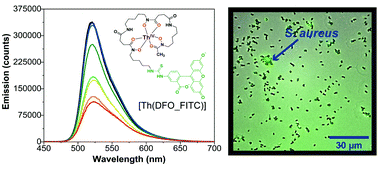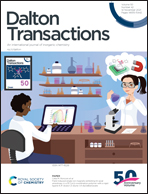ThIV–Desferrioxamine: characterization of a fluorescent bacterial probe†
Abstract
Diversifying our ability to guard against emerging pathogenic threats is essential for keeping pace with global health challenges, including those presented by drug-resistant bacteria. Some modern diagnostic and therapeutic innovations to address this challenge focus on targeting methods that exploit bacterial nutrient sequestration pathways, such as the desferrioxamine (DFO) siderophore used by Staphylococcus aureus (S. aureus) to sequester FeIII. Building on recent studies that have shown DFO to be a versatile vehicle for chemical delivery, we show proof-of-principle that the FeIII sequestration pathway can be used to deliver a potential radiotherapeutic. Our approach replaces the FeIII nutrient sequestered by H4DFO+ with ThIV and made use of a common fluorophore, FITC, which we covalently bonded to DFO to provide a combinatorial probe for simultaneous chelation paired with imaging and spectroscopy, H3DFO_FITC. Combining insight provided from FITC-based imaging with characterization by NMR spectroscopy, we demonstrated that the fluorescent DFO_FITC conjugate retained the ThIV chelation properties of native H4DFO+. Fluorescence microscopy with both [Th(DFO_FITC)] and [Fe(DFO_FITC)] complexes showed similar uptake by S. aureus and increased intercellular accumulation as compared to the FITC and unchelated H3DFO_FITC controls. Collectively, these results demonstrate the potential for the newly developed H3DFO_FITC conjugate to be used as a targeting vector and bacterial imaging probe for S. aureus. The results presented within provide a framework to expand H4DFO+ and H3DFO_FITC to relevant radiotherapeutics (like 227Th).



 Please wait while we load your content...
Please wait while we load your content...
